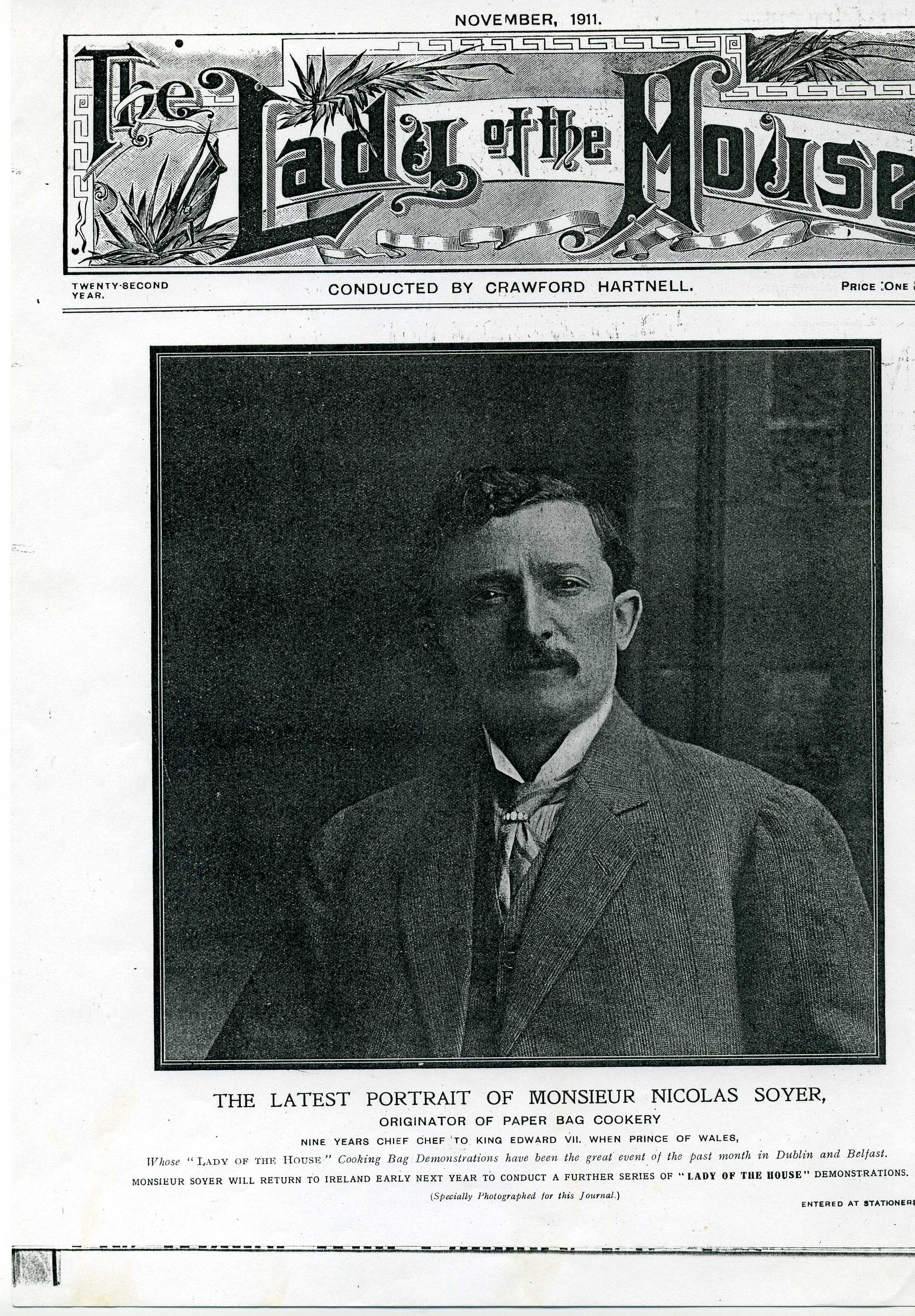
03 Oct Another Soyer who was considered the best chef in the world in his time, and claimed he was the grandson of the ‘Great Soyer’.

New York Times article about Nicolas Soyer circa 1911
Another Soyer who was considered the best chef in the world in his time, and claimed he was the grandson of the ‘Great Soyer’.
Onto the culinary stage of London in 1911, stepped a man, a Frenchman, with a brown paper bag and said: “If you cook with this you will taste food as you have never tasted it before”. This was no idle boast – it was true. He claimed that for nine years he had been the travelling chef for King Edward VII (when Prince of Wales) but was now the head chef of Brook’s Club, London. He also claimed his grandpere (grandfather) was Alexis Benoist Soyer. The man’s name was Nicolas Marius Soyer and his Paper Bag Cookery system was about to take London and continental Europe by storm.
On the 17th May 1911, The Daily Chronicle introduced Nicolas and his paper-bag system of cooking to the world. From the 17th May 1911 until 30th June 1911 they carried daily articles, sometimes two-columns long. It did not take the Daily Chronicle long before they realized they were on a winner with backing Nicolas Marius Soyer and his system, they started to offer ‘gratis’ to any reader that requested one, the bag called ‘Kookera’ with Nicolas Soyer’s signature on the front. Which, was formulated by a company called James Spicer & Company in Birmingham who had worked closely with Soyer in developing the bag. Soyer claimed in the past he had had many mishaps with the development of his idea of cooking ‘En Papillote’. He noted even in a paper-bag cooking contest with a German chef Herr Lampert, although he won, his food still tasted of paper. Spicer’s resolved this problem for him, if their bag did not touch any side of an oven and was placed on a grid, it would not catch fire or burn and would produce delicious food.

A cartoon that appeared in the Westminster Gazette.
The Chronicle could not keep up with demand and went into partnership with James Spicer & Co in supplying Soyer’s ‘Kookera’ bags. The Chronicle then funded Nicolas’ first demonstration of Paper-Bag Cookery, which took place on 30th May 1911, at Queen’s Hall, Langham Place, London, with three sittings before an audience of 400 people, making 1200 a day. Later, the Chronicle decided to fund Nicolas touring England giving demonstrations of his now-famous system. Later demonstrations moved from Queen’s Hall to Gamages (large store in London) and Gidea Park, Romford London and then some of the major towns in the provinces. Earlier at the beginning of May, Soyer wanting to introduce his system, therefore, he invited all of the press to his demonstration at Brook’s Club, the only journalist to turn up was from the Daily Chronicle. During May 1911 the only money Soyer was earning was from his job as Head Chef at Brook’s. Unfortunately, on 31st May 1911, he was instantly dismissed because of a cartoon in The Westminster Gazette on 30th May 1911. (to make sense of the cartoon, the then government called an election and under the Parliament Act, wanted to stop the house of Lord’s interfering with legislation). However unfortunately for Soyer one of the chickens was a drawing of Lord Lansdowne, who was a trustee of Brook’s Club. Nicolas would claim he left Brook’s on his own accord, which according to Brook’s archives is simply not true. I was also surprised to discover that Nicolas Soyer had only been made head chef on 10th December 1910.
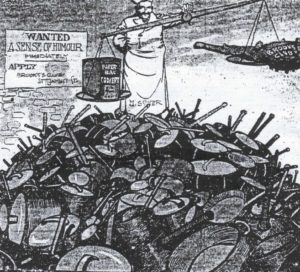
Cartoon published in The Daily Chronicle in response to The Westminster Gazette, suggesting Brook’s Club gets a sense of humour.
In response to Nicolas’ sacking, The Daily Chronicle printed their own cartoon on the 4th June 1911. Suggesting that Brook’s Club needed a sense of humour. This was a rather surprising response as Brook’s Club like the Reform Club was a Liberal club and the Daily Chronicle was a Liberal supporting newspaper. The Chronicle also reported there was a heavy demand of Soyer’s bag from Canada, USA and Australia. James Spicer also reported that had just sent a very large shipment of bags to Australia. Because of the heavy demand for recipes for Paper-Bag Cookery, both to the newspaper and at demonstrations. The Chronicle persuaded Nicolas Soyer to publish a book, it was called Soyer’s Paper-bag Cookery. He asked a clerk at Brook’s to type it for him, but later, that same clerk had to take Soyer to court for payment. (This was a sign of things to come). Later in America in 1912, their edition was called Soyer’s Cooking in Parchment Paper. However, despite The Daily Chronicle having helped create the Paper-Bag Cookery craze their interest was waning, their articles decreased to half a column, then just a couple of paragraphs and on the 30th June 1911, published their final article on Paper-Bag Cookery. Another newspaper who took a very brief interest in Nicolas Soyer for a few days in May 1911 was The Daily News who carried several articles about Alexis Soyer when its editor was Charles Dickens. However, The Daily News (who would combine with The Daily Chronicle in 1930) discovering that the Daily Chronicle was writing about Soyer instantly stopped. However, they had approached a chef called Charles Herman Senn to be their Paper-Bag Cookery expert and they got a company called Messers James Dickenson & Co Ltd., to make a bag called Royal Hart Household Bag, there were soon reports of these bags exploding causing fires in the ovens, which put an end to the Daily News’ interest in Paper-Bag Cookery.
The Daily Express seeing how popular the articles about Paper Bag Cookery were published in the Daily Chronicle had been, entered a circulation war with them. They used Charles Herman Senn as their expert. Senn seemed to have learned from his mistakes at The Daily News. He would now also claim that the secret of Paper Bag Cookery was in the heavy greasing – either fresh dripping or olive oil – of the interior of the bag. The Daily Express, which saw the claims that The Daily Chronicle was making about Nicolas’ ‘Kookera’ bag being the only genuine article and that it had been independently tested by analytical chemists Messers. Sindal and Bacon. They had their own bags, which were called ‘Daily Express Papakuk’ – and were manufactured by Messers Leopard & Smith – analysed by an independent company Messers Clayton, Beadle and Stevens, which they passed. The Daily Express also made the claim “Housewives worried by inferior substitutes should look for the words ‘Daily Express Papakuk’ embossed on every bag”. When Nicolas published Soyer’s Paper Bag Cookery, The Daily Express responded by publishing their own book called Daily Express Paper Bag Cookery Book. Also, Charles Hermann Senn published his book in 1911, which was supported by The Daily Express called ‘Paper Bag Cookery Manuel.” Senn and the Daily Express did a lot of damage to Nicolas’ reputation and his system. No one had advised Nicolas Soyer to protect his system by acquiring a patent for it.

New Cookery for Ireland Nicolas Soyer The Lady of the House
In August 1911 Soyer went to Scotland to promote his Paper-Bag Cookery system, this was funded by Sir James Leng’s Dundee Courier and Dundee People’s Journal. He toured Edinburgh, Dundee and Glasgow, by November the Dundee Courier started to print articles such as ‘The Limitations of Paper-Bag Cookery’ suggesting that people will still prepare steaks as normal, cooking them on an oven despite losing some juices in the fire. Also suggesting that people will still pickle fruit and make cakes in the normal way. The last article appeared in the Dundee Courier on 30th November 1911. However, Soyer had already left Scotland and had gone to Dublin, Ireland. This time he was being sponsored by ‘The Lady of the House’ who in their 15th September 1911, issue informed their readership that Nicolas Soyer would be giving demonstrations from October at The Rotunda Rink Hall in Dublin. Like all the other newspapers they funded Soyer, his demonstrations and the selling of his Paper-Bags. In their last edition for 1911, The Lady of the House claimed Nicolas Marius Soyer would be returning to Ireland in the new year to give some more demonstrations before his tour of the United States.
For Soyer 1912 would be a very busy year, in January he gave demonstrations in Manchester, in February he returned to Ireland and gave demonstrations in Belfast. He then returned to England and gave demonstrations in Leicester and in April gave demonstrations in Leeds then Sheffield. In May 1912 he sailed to Quebec, Canada and on the 14th May until the 17th he gave demonstrations in Montreal. He then moved on to Ottawa to give demonstrations 29th-30th May. He then went to New York to give his very first USA demonstration on 11th June. Followed by demonstrations in Brooklyn on 13th and 14th June. He was joined by his wife who sailed to New York on 22nd May 1912. He then returned to Ottawa and gave his final demonstrations 9th, 10th, 11th and 12th October 1912. He then returned to New York, where he and his wife sailed to Liverpool, England arriving on 16th November 1912.

Canadian Window display showing Soyer’s Paper-Bag Cookery System, whilst Nicolas Soyer was inside giving a display.
In America and Canada, the claims about Soyer’s achievements were very interesting. The New York Sun newspaper claimed he was a celebrated Paris-London Chef, that he was travelling Chef to King Edward VII (who had died on 10th May 1910) and that for many years in charge of Cuisine at Brook’s. When he was only at Brook’s Club for five months. Also, the newspapers claimed he had been the chef for the dowager Duchess of Newcastle, where he first started to experiment with Paper Bag Cookery. He also worked for Sir Hebert Scarisbrick Naylor-Leyland and he also worked for Lord Suffolk who was the Earl of Suffolk, they also suggested he taught the children of the Royal family to cook including Canada’s own Princess Patricia of Connaught. In 1911 and 1912 articles about him were prolific in America. However, he did not author them. With the first printing of ‘Soyer’s Paper-Bag Cookery’ the American publisher, Sturgis & Walton had an American cooking expert to endorse his book. First, it was Martha McCulloch Williams and the second was Virginia Terhune Van de Water who quickly published her own book ‘Paper-Bag Cookery’ in 1911. Martha McCulloch Williams wrote several articles and recipes about Paper-Bag Cookery, she did acknowledge Soyer, but her name was the tagline. These articles got picked up by hundreds of local newspapers, both in America and Canada. I doubt Nicolas Soyer earnt any commission from these articles. Rather than newspapers funding his Paper-Bag Cookery system and his demonstrations he did this himself. In England, a lot of damage was done to him and his reputation, by Cooks rushing out with their own claims about Paper-Bag Cookery, such as Charles Herman Senn and Vera Countess Serkoff, both plagiarised Soyer’s Paper-Bag Cookery book, but doing the most damage was The Express newspaper. In America in was Martha McCulloch Williams, Virginia Terhune Van de Water, Helen Cramp and Emma Paddock Telford and a monthly magazine named ‘Paper Bag Cookbook’.
Back in England, The Leeds Mercury 7th April 1913, carried an advert claiming ‘Return of the Greatest Living Chef. Mons. Nicolas Soyer. Also stating that he had ‘Just Returned (seven months ago) from a Successful Demonstration Tour in the United States and Canada. ‘Will be demonstrating his Paper-Bag Cookery System on the 8th, 9th, 10th and 11th of April 1913.’ It does appear that the bubble of ‘Paper-Bag Cookery’ had burst, the demonstration at Leeds was to be Soyer’s last. But Nicolas Marius Soyer had no one to blame but himself, he was the Master of his own downfall. From the first demonstration of Paper-Bag Cookery and all others, Soyer’s mantra was that the cook can put away their pots and pans because they can cook anything with his Paper-Bag System. They can enjoy the saving on Fuel and Money, there would be no horrid smells in the Kitchen. Nicolas Soyer decided to publish another book on 16th July 1912, published by Andrew Melrose who published Soyer’s Paper-Bag Cookery. The book was called Soyer’s Standard Cooking, the inside promotion claimed it was ‘A Complete Guide to the Art Cooking Dainty, Varied, and Economical Dishes for the Household.’ Soyer’s Standard Cooking was a complete contradiction of his first book, making him somewhat of a hypocrite. It did carry some Paper Bag recipes, but the majority was using the top of the oven or using fire and using pots and pans.
The same time as Paper-Bag cookery fell out of vogue with the British Public, so to did it in America, Canada and Australia, this was the same time as Nicolas’ demonstration in Leeds in 1914. Paper-Bag cookery was dead, as the country had gone to war on 29th July 1914 Paper-Bag Cookery would have been an ideal system for the fighting forces and Nicolas Marius Soyer could have claimed bragging rights as he equalled Alexis Benoist Soyer’s design of a new style of a cooking stove during the Crimea war. But unfortunately, it was not to be. One company that suffered because of the decline in sales was James Spicer & Sons they placed an advert in The Birmingham Daily Mail (24th February 1917) for Soyer Bags, suggesting that by using them it was both “Cooking Economy and Patriotism are Synonymous” suggesting that using Paper-Bags for cooking helps the war effort.

Victoria Hotel, Woodhall Spa. destroyed by fire 20th April 1920.
From 1914 to 20th April 1920 Soyer worked at The Victoria Hotel, Woodhall Spa in Lincolnshire. He worked there until a fire destroyed the hotel. We know on 19th December 1920 he had an illegitimate son with his common-law wife (not too sure what happened to his legal wife Marie Lucie (Madeline) Dufourd). Information about Nicolas is then very sparse, according to his son who recalls “going to see his father at various big houses”. In 1932 until his death of a heart attack 10th May 1937 he worked for Henry Talbot de Vere Clifton at Lytham Hall, Lancashire. Clifton insisted all his staff called him ‘Milord’ although he was not knighted or ennobled. Nicolas Marius Soyer was given a Requiem Mass at St Peter’s church and he is buried in an unmarked grave at St Anne’s Park Cemetery, Lytham. Like Alexis Benoist Soyer all of Nicolas’ goods and chattel were seized by his executor National Provincial Bank. Indicating he made no money out of Paper-Bag Cookery.
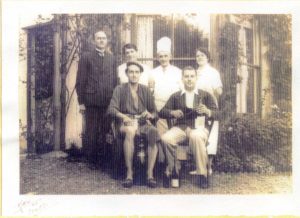
1936. Henry Talbot de Vere Clifton, sitting on the left. behind him, Nicolas Marius Soyer, on his left his common-law wife.
The local Newspaper, Lytham St Anne’s Standard claimed of Nicolas Soyer “was the travelling chef for King Edward VII and acted as a chef to King George V. while it is recalled that he taught Queen Elizabeth cookery as a child at Glamis Castle.”
The truth about Nicolas Marius Soyer.
When I first carried out my first research on Nicolas Soyer it was in the year 2000. The only information available to me was his biographies printed in his two books. In France, if you knew the area for marriage in Paris you had to go to Paris archives 18 Bd Sérurier, 75019 Paris, France. The same as if you were looking for birth in Meaux you had to visit the Seine-et-Marne Archives if you did not know the area for birth, deaths and marriage you had no chance of gaining any information. Researching in the UK you first went to the Society of Genealogists at 14 Charterhouse Bldgs, Goswell Rd, Barbican, London, in the hope someone might have done some research on the people you are researching. There you had an index to the Mormons IGI. If you wanted to research people’s births & marriages you went to St Catherine’s House, Kingsway. London. To find deaths you went to Alexandra House, Kingsway. To look through the censuses you went to Portugal Street, London. To look through family records you went to The Public Record Office, Chancery Lane, London. To find wills and divorces you went to Somerset House, London and you then followed through by going to local county archives. For Nicolas, I went to Westminster archives and Guildhall. I also spent a lot of time at the London Metropolitan Archives, 40 Northampton Rd, Farringdon, London. If you wanted to look through newspapers’ articles you went to the Newspaper Library at Colindale or the British Library. In doing this you looked through Microfiche readers and Microfilm readers. Not very user-friendly.
To bring the research on Nicolas Marius Soyer up to date, things have changed you can do everything online, with some sites such as Ancestry.com you need to pay a fee. Most of the national and local newspapers are online. The Times have their own online portal. All American local and national newspapers are online. The same for Australia. Wills and divorces are online, all available for a fee. However, the best of them all is France all their Actes d’elat Civil, Table Annuells, Table Decenneles and Digital Census for every village, town and city are available online for no charge. Because of that, I have managed to trace Alexis Benoist Soyer’s maternal line back to 1699. I have tracked his paternal line to 1734. I have also tracked Alexis’ line to 1901. Like most of Europe women kept their maiden name throughout their life, it did not change despite their marriages, births or deaths. This gives a researcher enormous help in their research. Very much like the Uk, France observed the hundred-year rule where 100 years had to pass before that information about an event is made public. However, there are some who argue that it should only be 30 years.
Nicolas seemed very evasive with public or government documents. His ages varied with each document, with a French census he was born in 1861, From his marriage certificate, he was born in 1867. From the 1911 English census he was born in 1866 and on his death certificate, he was born in 1863. From circa 1910 Nicolas Marius Soyer constantly told newspapers and people that he was the grandson of Alexis Benoist Soyer. To have the surname Soyer you are either born illegitimate (I do prefer the way the French describe that state, naturelle.). But Soyer had no daughters so that counts that out. So, Alexis’ had one naturelle son called Jean Alexis Lamian. However, in 1852 Alexis travelled to Paris and with his son and visited a public notary, recognizing Jean as his son, which allowed Jean Lamain to use the surname Soyer, thus becoming Jean Alexis Soyer. Jean kept his first name throughout his life. Yet Nicolas kept referring to him as Alexis Soyer. On the 5th May 1866 in Beaumont-sur-Oise Jean Alexis Lamain married Celina Augustine Angelina Moreaux. Jean had to show the death certificates of his father and mother and the 1852 Notary form allowing him to call himself Soyer, before he could marry. Jean and Celina had five children, one dying in 1871. I will just use the first three children to make a point. So, eight months after their marriage the first child Alphonse was born 14th Jan 1867, the second Edmund 1st February 1868 and the third child 7 June 1870. Therefore, the problem is that no way was a child born before Alphonse as Celina was in gestation with Alphonse virtually from her marriage date. So, the ages he gives on the marriage certificate and enters on the 1911 census form are impossible.
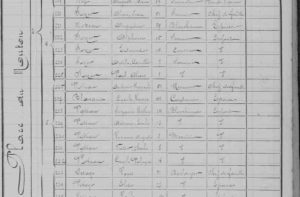
1881 Decenneles Table from Montmorency, Val-d’Oise. France. Showing Alexis Soyer’s son Jean Lamain Soyer, his wife Augustine Moreaux. His three sons Alphonse aged 15, Edmund aged 14 and Paul Alexis aged 1, and his daughter Adele Camille aged 8. Sorry about the quality of the image.
In Nicolas Soyer’s second book Soyer’s Standard Cookery which was published in 1912, he makes several self-aggrandizing claims. One of them…..” he worked for the dowager Duchess of Newcastle and Sir Herbert Naylor-Leyland followed by a period of eight to nine years during which he speculated with various success in certain large enterprises.” In Standard Cookery there is a brief biography of Alexis Soyer, strangely it is verbatim from ‘Memoirs of Alexis Soyer’ even down to the incorrect date of birth, one would have thought he would know his own grandfather’s birth date. Also, he mentions great chefs such as Alexis Soyer and Louis Eustache Ude, but he appears not to know that Ude was Alexis’ best man when he married Emma Jones 12th April 1837. He now is saying that he is the grandson of the ‘Great Soyer’ and in the Lady of the House it is now claimed that he was the travelling chef of Edward, Prince of Wales, it has to be noted that he only starts to make this claim after Edward VII died in 1910.
In looking at the statement he made in Soyer’s Standard Cooking “followed by a period of eight to nine years during which he speculated with various success in certain large enterprises.” I found Nicolas Soyer on 29th October 1901 in Cheltenham. He lived there until 1908/9. Unfortunately for me, a very charming lady (Jill Waller) from the Cheltenham Local History Society Informed me that in June 1918 the financial committee instructed the borough treasurer to destroy all old rate books, account books and papers which was not needed. Then on top of that ten years later, a serious fire in the town hall destroyed some of the 19th & 20th-century records. Therefore, I can only go by Cheltenham local papers. As a Historian with a BA(Hons) in English Local History and an MA in Historical Research I use to like getting another source to confirm a newspaper article. As we know today (2020) there is often a shout of fake news, the manipulation of the ‘Fourth Estate’. Much of that would occur in Nicolas’ time and we are beginning to learn that Nicolas Soyer was not above the manipulation of facts, himself.
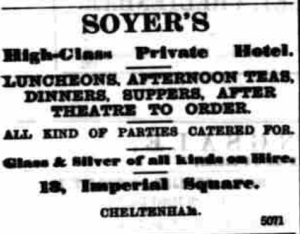
Soyer’s Private Hotel
In the Cheltenham Examiner 1st December 1901, this advert appeared and the advert itself would run daily in one or two local papers. Then we discover from the 28th March 1903 edition of the Cheltenham Chronicle and Gloucestershire Graphic in an article the reporter had written this ‘The tables were prettily decorated by Madame Soyer’. It appears that Nicolas was a member of the Cheltenham Constitutional Club. We can see why when the local MP Mr J T Agg-Gardener mentioned this in his after-dinner speech “…another point which had caused some controversy was the recent unfair treatment by some benches of magistrates of license holders”. From 1901 to 1905 virtually every license application in Cheltenham was objected to by the police. Nicolas himself has been having trouble in the courts to obtain a restaurant license. Later in several newspaper articles, ‘Madame Soyer’ is referred to as Nicolas’ wife. In a later newspaper, I discovered that Madame Soyer was the leaseholder of Soyer’s hotel, so I have no idea if the hotel is named after her or Nicolas.
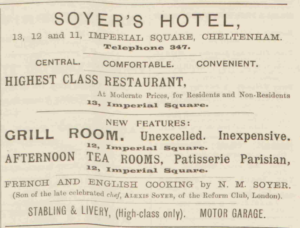
Advert in the Looker-On 18 June 1904. N.M. Soyer Claiming son of the late celebrated Chef, Alexis Soyer, of the Reform Club, London.
In an application for a restaurant license, he claimed he fed about 285 covers per week. If diners wanted wine, it had to be ordered from a local wine merchant or customers brought their own bottles. The police claimed there was one licensed house to every 285 residents in Cheltenham. Soyer claims he has been on the premises since 11th October 1901, also, he is prepared to keep the business for 20 years and was prepared to surrender some licenses he already held in Cheltenham. The application was denied.
In The Cheltenham Chronicle 27Th January reported (one of many, as it appears Nicolas does not like paying staff wages -he lost all the cases) an ex-member of staff Antoine Kovacs claimed he was employed by Madame Soyer through the agency of Hotel Employers Society in London. He also claimed he was first employed at M. Soyer’s House in Cleeve Hill. This must be the Carlton Club which Soyer had been prepared to swap for a restaurant license for Soyer’s Hotel. (The Carlton Club was an Ante-69 beerhouse, where the license was granted by magistrates but they were very restricted in why they could refuse such license).Soyer’s defence in this claim was that he did not employ staff for wages but for board and lodgings, which was dismissed. He eventually lost the case and he was ordered to pay Kovacs £4 3s. In March he lost a case against Emil Wacksmith for £4 15s 6d. This did not sway Soyer for applying for a license again according to The Cheltenham Examiner 16th April 1904, in addressing the court he claimed, “he was the son of the Great Soyer of The Reform Club”. He also appeared with a petition signed by local residents in support of his claim. Again, he offered to close the Carlton Club in exchange for a license for Soyer’s Hotel. This time he won, but the License would be held back until the closure of the Carlton Club.

Advert Cheltenham Look-On 5 August 1905 Showing Madame E. M. Soyer moving to Wolseley House. M. Soyer the chef.
Eight months later Nicolas Marius Soyer was in court again. According to The Daily Chronicle 14th January 1905. He filed for a petition of bankruptcy on 24th December 1904 and has now been adjudged bankrupt. His liabilities of £1,880 13s 7d were to 34 unsecured creditors and £1,548 0s 7d to one secured creditor. His assets were 6s 11d in the bank, stock in trade £300 and £1,180 in furniture. Soyer claimed the reason why he became bankrupt was “The want of capital and people not paying cash” According to the Cheltenham Citizen 25th March 1905. Soyer in the bankruptcy court was asked if he had any interest in his father’s will. Soyer claimed it was not a will but a marriage settlement. The interest was a small piece of land about 5/6 acres about £100. But he had never seen the settlement, which was now in the procession of his mother, who was still alive and on her death the dividend would be divided by himself, his brother and sister. [As he was saying he was the son of the Great Soyer, he should know he was an only child as for Alexis’ son Jean Alexis Soyer, Jean Alexis Soyer’s only son had five children, one dying in 1871, as of 1914 all the four children were alive, married and having children themselves]. The Echo 27 February 1905 reports Soyer is in court again. This time he seems to have mislaid his license, which he had to hand in, as the creditors wanted to keep Soyer’s Hotel open. It took until July to resolve this case, whereby the licensing court jut issued another one. I think it was a delaying tactic on behalf of Soyers to delay matters until they were ready to move out and open Wolseley House Hotel, as the above advert shows. Also, the report referred to Madame Soyer as Madame Helena Soyer, Nicolas’ wife. Nicolas Soyer’s creditors had to apply, after 26th January 1906, to Charles Castle, 2, Regent Street Chelmsford for a final dividend of 3¾d in the pound. Nicolas was released from bankruptcy 27th February 1907. Articles about the Soyer went quiet until 1909. Several papers reported the same story the case started in 1909 adjourned and then reopened late 1910. It did not really involve the Soyers, who seem to have disappeared from Cheltenham. Briefly, both cases involved Mr Peter Benedall, who was a furniture remover, it appears he had given furniture to Soyer’s Hotel and Madame Soyer at Wolseley House on the hire system. Benedall claimed when Soyer went bankrupt he put his own manager, claiming Soyer was just a manager that he had employed, when he left, he employed a man called Sawyer. He later withdrew this claim. He then claimed his wife was the true proprietor and used her own money to run Soyer’s Hotel. His wife refuted this claim saying she was just the manageress at first. That the Soyers controlled Soyer’s hotel until 1908. Then she took on the responsibility of being the proprietor, hiring and firing and paying the bills. The judge claimed he needed time to sort out all the myths that had been put before him. When the case was resumed later in the month, both parties withdraw every statement they had said before. It appears that Soyer’s Hotel was now closed for business. Attending the court was a Mr J H Boulter of Messers Cornelius and Butler who were the agents for Soyer Hotel, deposed that the lease now stands in the name of Madame Soyer, as it always had since the hotel was so named and that Mrs Benedall was paying the rent from her account at Lloyds bank. Mrs Benedall had been given permission by Madame Soyer’s solicitors to run the hotel. She was asked if Soyer’s Hotel had been a success, she answered: “yes, fairly”.
When Nicolas Marius Soyer made the statement that between testing his paper-bag cooking and bringing it to market he claimed, “followed by a period of eight to nine years during which he speculated with various success in certain large enterprises.”. As you can see this was a very spurious statement full of fabrication
I was very surprised that when I looked through Cheltenham Local papers for the year 1911 and 1912 during the period of the heyday of Soyer’s Paper-Bag Cookery. I could not find one article that associated Nicolas Soyer with the Nicolas Marius Soyer of Soyer’s Hotel in Cheltenham after all it only closed late 1910. He must have left some unhappy people, especially the ones who were creditors of Soyer’s Hotel and only got 3¾d in the pound and it would appear from the newspapers that Soyer was making money out of his new system of cooking. I was not surprised that I have not been able to find any information about Madame E M (Helena) Soyer, In England, I could not find an earlier marriage for a Nicolas Soyer. Here and in France, I would need to know Madame Soyer’s family name, where she was born, even to have a 1% chance of finding her in France.

Marriage Certificate 1910
However, I did find a marriage in 1910 at the Central Registry Office, The Strand, London. between a Marius Soyers, a bachelor who is a Hotel Keeper whose father Alexie Soyers was also a Hotel Keeper. He marries a Marie Lucie Dufourd a spinster whose father is Jean Dufourd. You will notice both their addresses are 118 Long Acre. Eight months later on the 2nd April 1911, the National Census takes place in England. Living at 118 Long Acre is Nicolas Soyer chef at Brook’s and his wife. They claim they have been married three years and that her first name is Madeleine who is from Paris, France. These are Marius Soyers and Marie Lucie Dufourd from the marriage 1910, as can be seen by the address on the census document and the wedding certificate. Also, in 1910 on the 8th July Nicolas Marius Soyer took extraordinary action. He applied for an English Passport. To get a passport in 1910 you just had to self-claim to the office of the Principal Secretary of Foreign Affairs, it was not until 1915 that claimants had to supply a photograph and a signature. Because Nicolas had this on the census form, he claimed his birthplace was Fulham, England. On the passenger lists when he and his wife travelled to America and Canada,  he always maintained he was English, and his wife claimed her name was Madeleine. On the census form, Nicolas aged himself by 2 years to 45 and Madeleine was 26 which is correct because she had a birthday between these two documents. Because she was born on 3rd February 1885 as Marie Lucie Dufourd to Pierre Dufourd and Celine Juliette Lerfave, in the 6 arrondissement, Paris France. (her witness was a childhood friend from Paris France. I have no idea why she called her father Jean and herself Madeleine. This would appear to be just another web Nicolas Marius Soyer has weaved himself. If he was married to Madame E M Soyer he has committed bigamy, which might explain the change in name. But, if he is being deceptive, he is not very bright by using the same address on both documents.
he always maintained he was English, and his wife claimed her name was Madeleine. On the census form, Nicolas aged himself by 2 years to 45 and Madeleine was 26 which is correct because she had a birthday between these two documents. Because she was born on 3rd February 1885 as Marie Lucie Dufourd to Pierre Dufourd and Celine Juliette Lerfave, in the 6 arrondissement, Paris France. (her witness was a childhood friend from Paris France. I have no idea why she called her father Jean and herself Madeleine. This would appear to be just another web Nicolas Marius Soyer has weaved himself. If he was married to Madame E M Soyer he has committed bigamy, which might explain the change in name. But, if he is being deceptive, he is not very bright by using the same address on both documents.
As for Nicolas Soyer’s claim that he was King Edward VII’s travelling chef for nine years. I wrote to the Royal Archives at Windsor and the Sandringham Estates. Neither had lists that had Soyer’s name on them. I was told that any member of staff would work for the Royal Household, not for a Royal Member and that all staff who had worked for the Royal Household longer than three months would be listed. Nicolas Marius Soyer was not, as one of the Royal Registrar’s very politely wrote: “The Archives at Windsor are most complete”. So, another fiction in Nicolas Soyer’s life, it was around this time he stopped calling himself the son of the Great Soyer. He was now referring to himself as the Grandson of Alexis Soyer. There was a reason for that, when he died, in his belongings was found a copy of ‘Memoirs of Alexis Soyer’ on page 240 and 242 was a big blue cross in crayon. These pages are all about Alexis son, Jean Lamain, later Jean Alexis Soyer. Nicolas must have realised he could not claim to be the son of Alexis Soyer, but he decided he could call himself the grandson because the book made no mention of them. Nicolas was not the son or the grandson, neither was he related to Alexis Benoist Soyer. Nicolas also took some information from ‘Memoirs’ I have already mentioned that he used its biography of Alexis Soyer and copied it verbatim in his second book. Also, he copied some of it for himself. He claimed he was destined for the church but took up cooking instead.
Amongst his other claims, he said that he had worked for the Earl of Suffolk and Sir Herbert Naylor-Leyland. I wrote to his great-grandson Sir Philip Naylor-Leyland, asking about Nicolas Soyer’s claim. He wrote that he could not find any records relating to Nicolas Soyer. I also wrote to the Earl of Suffolk’s estate in Malmsbury a very similar response “we do not have such records”. Soyer inferred the Lord Suffolk was his last employer before he started work at Brook’s Club. Again, this is wrong I found in Brook’s Club Archives That Brook’s had asked for a reference from Aubrey Hopwood, who Soyer never mentions working for. Aubrey Hopwood was an author and lyricist and he was a member of Arthur’s club rather than Brook’s Club both being in St James London.
Soyer in 1920 had a son whose mother was Janet Beaveridge who was known as Madame Soyer for the last 17 Years of Nicolas’ life. Again, Nicolas appears to have lost a wife. The Beaveridge family always wondered why Nicolas and Janet did not get married. I expect it was because of the previous wives. Nicolas was a Roman Catholic, he would have to show the birth certificates of his parents, plus a divorce or death certificate of his wife. It does appear when matters became difficult, Nicolas Soyer would run away leaving other people to sort the problems out.
They say all charlatans, tricksters make mistakes; Nicolas was one of them. He first called himself the son of Alexis Soyer, then he claimed he was one of three children and his father had left a will for 5/6 acres of land to be divided between himself, his sister and brother. I have shown what a fraudulent statement that was. Nicolas would start to claim that he once worked for the famous Papon, who was a confectioner in Clement-Ferrand. I found him in the 1881 French census of Clement-Ferrand. I found the only Patisserie in Clement-Ferrand it was at 65 Rue St Genes, the head was Jacques Papon, Pâtissier, he was there with his wife and staff. I have told you that Nicolas Soyer was buried in an unmarked grave, that was fortuitous, because if they had put a headstone with Nicolas Soyer’s name on it. It would have been the wrong name as Nicolas Soyer’s real name was Marius Soulier.
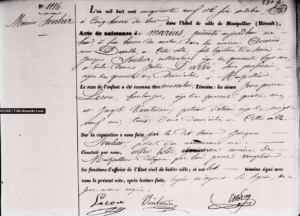
Marius Soulier Birth Certificate 6th Oct 1859 Montpellier, Herault, France
This is Marius Soulier’s birth entry 6th October 1859 in Montpellier, Hérault, France. His grandparents were Jean Soulier and Marie Soular. They had a son Jacques Soulier born 8 June 1812 Montpellier, Hérault, France. He married Elizabeth Bestiou on 13 Jan 1839 Montpellier, Hérault, France. They had two sons Louis Noel Soulier 21 December 1839 Montpellier, Hérault, France. and Jean Theodore Soulier 12th April 1842 Montpellier, Hérault, France. Elizabeth Bestiou died 10 May 1843 Montpellier, Hérault, France. Jacques Soulier married for the second time to Julie Darde (1821 – 20 Nov 1892) on 8 Nov 1846 Montpellier, Hérault, France. They had four children. Rose Soulier 10 September 1847 Montpellier, Hérault, France. Marie Soulier 24 Dec 1854 died * August 1855 in Montpellier, Hérault, France. Then Marius Soulier 6 October 1859 in Montpellier, Hérault, France dies 10 May 1837 Lytham-St-Anne. Louise Soulier 5 June 1864 Montpellier, Hérault, France.
If ever there was a man who suffered from mythomania it certainly was Marius Soulier (AKA) Nicolas Marius Soyer.



Sorry, the comment form is closed at this time.